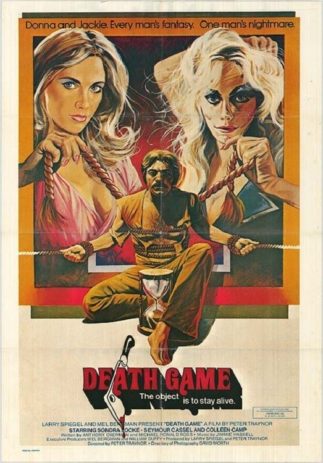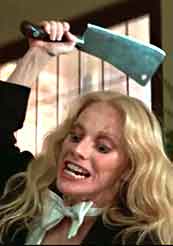 A happily married man unwisely lets two hot chicks into his house for a night of you-know-what, only to have them turn into psycho bitches from Hell the next day in DEATH GAME, one of the most hopelessly inept yet curiously stylish and unnerving psychofilms ever made. It was remade twice, as Mexican sexploiter VICIOSAS AL DESNUDO (1980) and the Eli Roth directed KNOCK KNOCK (2015), neither of which will displace the original film.
A happily married man unwisely lets two hot chicks into his house for a night of you-know-what, only to have them turn into psycho bitches from Hell the next day in DEATH GAME, one of the most hopelessly inept yet curiously stylish and unnerving psychofilms ever made. It was remade twice, as Mexican sexploiter VICIOSAS AL DESNUDO (1980) and the Eli Roth directed KNOCK KNOCK (2015), neither of which will displace the original film.
Actress and sometime director Sondra Locke seems destined to be best known as Clint Eastwood’s ex, but in DEATH GAME (a.k.a. THE SEDUCERS, 1976) she creates one of the most memorable psycho bitches in movie history, a character both hopelessly deranged and deeply seductive in the top hat, magician’s cloak and black nylons she wears throughout the latter half of the film (B-movie veteran Colleen Camp is nearly as potent as her partner in crime). That’s despite the fact that in her 1997 autobiography Locke bemoans the film’s cluttered shoot and director Peter Traynor, who apparently “didn’t have any idea what he needed to be, was, or should be doing.” She also claims actor Seymour Cassel was so appalled by the chaotic nature of the production he refused to loop his lines, meaning all his dialogue was redubbed by the film’s cameraman David Worth!
“[Sondra Locke] creates one of the most memorable psycho bitches in movie history…”
Getting back to the good stuff, we can credit production designer Jack Fisk, who creates a disturbing subconscious landscape that’s fully up to the high standards set by his imaginative work on two other seventies classics: PHANTOM OF THE PARADISE and ERASERHEAD. Fisk’s wife Sissy Spacek is incidentally credited as a set decorator, as is future actor/director Bill Paxton.
…credit production designer Jack Fisk, who creates a disturbing subconscious landscape that’s fully up to the high standards set by his imaginative work on two other seventies classics: PHANTOM OF THE PARADISE and ERASERHEAD.

George, a contented middle aged man, settles into his luxurious San Francisco house after his wife leaves town to tend to her ailing mother. Two attractive young woman show up at his door claiming their car has broken down; George allows them to stay in the house while they wait for their “friends” to pick them up. They waste no time making themselves at home, which inevitably leads to a wild threesome in a bathtub, after which George, being the sexist pig he is, expects the girls to leave.
The next morning, however, George finds them in his kitchen cooking breakfast. After some arguing (they threaten to tell the police they’re underage, a claim that seems pretty spurious) George agrees to drive them to a bus station…but when he arrives home later that evening the girls are back in the house waiting for him. In short order they tie him up and dump all the food in his refrigerator onto his head. This inspires a call to a grocery delivery boy, who ends up drowned in George’s fish tank. The girls stage a mock trial and sentence George to death in the morning, leading to more wholesale destruction during which George’s cat is thrown through a window. In the morning, however, the ladies decide to let George live; they exit his house in high spirits, but are mowed down by an ASPCA van (revenge, I guess, for killing the cat).
At its start DEATH GAME looks every bit like the tawdry exploitation programmer it was no doubt intended as. Those who abandon the film in the opening twenty minutes will have no idea of what makes it so effective, but I can’t say they wouldn’t be justified in doing so: the opening credits aren’t exactly inspiring, scored as they are by an obnoxiously pretentious pseudo-kiddie song called “My Dear Old Dad.” There’s an equally ridiculous title card that tries to coat the proceedings in a veil of social responsibility. And the outrageous three-some between Cassell, Locke and Camp simply must be seen to be believed, decked out with so many dissolves that any potential eroticism is completely obliterated, and scored with high spirited disco music that’s completely out of place.
But the film’s latter half is something else entirely: a deeply unnerving descent into insanity with an authentically deranged ambiance. If Locke is correct in her claim that director Peter Traynor didn’t know what he was doing than perhaps that explains the strange way the camera lingers over Locke and Camp’s freaky doings; she writes that “whenever the director didn’t know exactly what he was doing, which was all the time, he would suggest that either Colleen or I break something, or eat something”. Also notable is the hallucinatory feel of Cassel’s trashed house, illuminated by an unearthly green fish tank light. It helps, of course, that the actresses are definitely game, investing their psychotic characters with infectious glee. Accidentally or not, this film is damned effective, although I’ll politely refrain from discussing that hopelessly ludicrous ending.
Vital Statistics
DEATH GAME (a.k.a. THE SEDUCERS)
First American Films
Director: Peter Traynor
Producer: Larry Spiegel, Peter Traynor
Screenplay: Anthony Overman, Michael Ronald Ross
Cinematography: David Worth
Cast: Seymour Cassel, Sondra Locke, Colleen Camp, Beth Brickell, Michael Kalmansohn, Ruth Warshawsky
